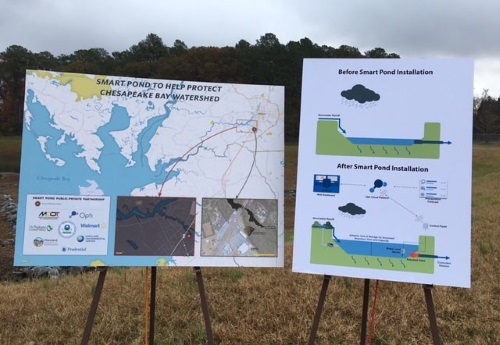The Maryland Department of Transportation recently unveiled three “smart ponds” built via a public-private partnership or P3 stormwater control project that seeks to reduce pollutants and curb local flooding.
[Above photo by Maryland DOT]
The agency said this “smart pond” project is the first of its kind involving a state transportation department and it involved the Maryland Department of Environment, Environmental Protection Agency, Walmart, and The Nature Conservancy.
The Maryland DOT said this “smart pond” technology – developed by Opti – uses sensors and software to monitor real-time conditions such as water level and storage volume. Then, using Internet-based weather forecasts, the system remotely operate valves that control timing and volume of water discharge from the ponds as longer retention time increases water quality by capturing more sediment and nutrients.
Thus, when rain is in the forecast, the system can automatically open valves to drain the pond prior to precipitation, the agency said – helping maximize stormwater storage efficiency and reducing downstream flooding.
“These smart ponds are another innovative way we’re working to improve the communities we serve,” explained Greg Slater, Maryland DOT secretary, in a statement. “We’re being responsible stewards of the environment while at the same time helping protect the infrastructure that supports our hard-working residents and businesses.”
The Maryland Environmental Service, The Nature Conservancy, and Opti originally signed a contract in July 2020 to retrofit three stormwater runoff ponds located at Walmart stores as “smart ponds.” Concurrently, the Maryland DOT plans to spend $3.25 million to purchase 80 acres worth of Chesapeake Bay impervious area treatment credits generated by the smart ponds at Walmart. After certification of the credits, the Maryland DOT will begin purchasing the credits this spring.
The agency said this smart pond partnership represents the first time a state department of transportation is purchasing credits from a Water Quality Trading Program. Maryland’s program created a water quality marketplace for credits generated by pollutant reductions elsewhere in Maryland’s portion of the Chesapeake Bay watershed – offering “market-based” economic incentives for pollutant reductions.
The cost to Maryland DOT for these new credits is about $37,500 per acre, including installation of smart pond technology and 20 years of monitoring, inspecting, operating and maintaining the ponds by The Nature Conservancy and Opti. That is significantly less than the average construction cost of $150,000 per impervious acre treated through stormwater control devices such as swales, bio-retention cells and stormwater ponds, the agency noted – and that $150,000 cost does not include operation and maintenance. Overall, the Maryland DOT said it owns about 800 ponds that could benefit from this smart pond technology.

